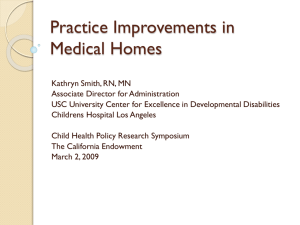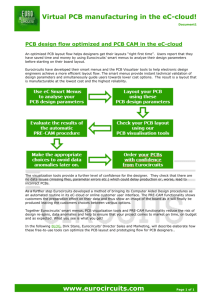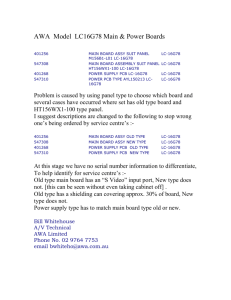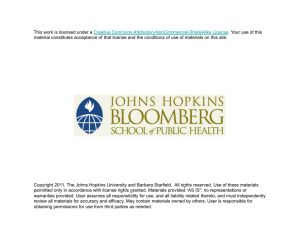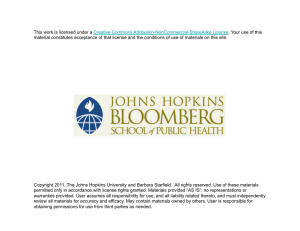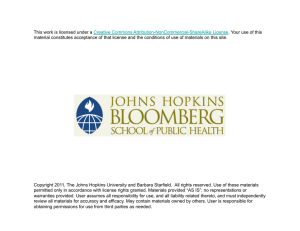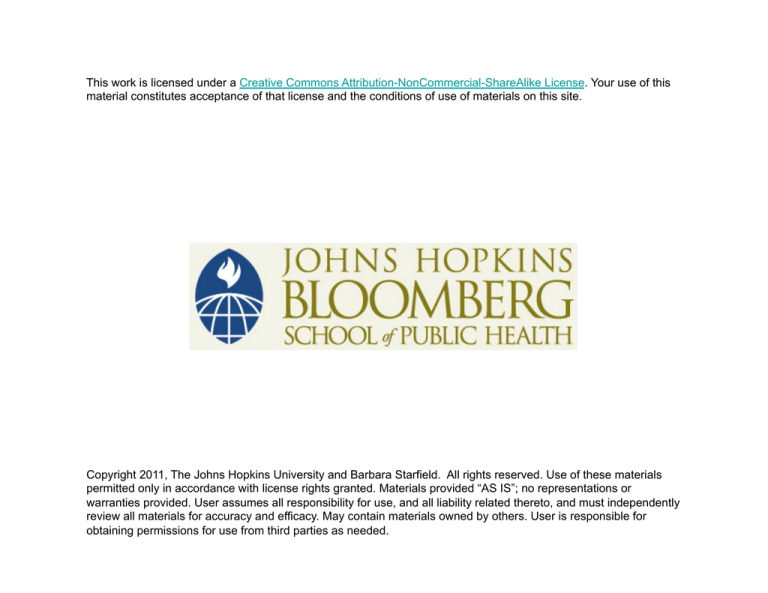
This work is licensed under a Creative Commons Attribution-NonCommercial-ShareAlike License. Your use of this
material constitutes acceptance of that license and the conditions of use of materials on this site.
Copyright 2011, The Johns Hopkins University and Barbara Starfield. All rights reserved. Use of these materials
permitted only in accordance with license rights granted. Materials provided “AS IS”; no representations or
warranties provided. User assumes all responsibility for use, and all liability related thereto, and must independently
review all materials for accuracy and efficacy. May contain materials owned by others. User is responsible for
obtaining permissions for use from third parties as needed.
Introduction
Barbara Starfield, MD, MPH
February 11, 2011
Strictly speaking, this set of annotated powerpoint slides
represents the third edition of the book Primary Care. The first
edition was published by Oxford University Press in 1992 and
was subtitled Concept, Evaluation, and Policy. Although there
was already recognition of the importance of primary care,
manifested by the World Health Organization’s Alma Ata
Declaration of 1978, the definitions provided by that
declaration were too general to be a guide to designing
primary care-oriented health systems. For the first time, this
first edition provided a practical way to convert the values and
principles into practice, by presenting a theoretical framework
within which the components could be specified in a way that
made them measurable. It was the first book ever to deal
systematically with the theoretical framework for primary care,
its components, and accomplishments in practice.
Starfield 08/10
PCB 7392
Within a short five years, so much had been
learned from research in primary care that a
new edition was warranted. Subtitled Balancing
Health Needs, Services, and Technology, it rereviewed the nature of primary care within
health systems in the light of growing interest in
the subject throughout the world.
This “second edition” updated existing
knowledge about primary care and included an
updated assessment of the state of primary
care in thirteen industrialized countries.
Starfield 08/10
PCB 7393
Now, more than ten years later, it is time to
update once again. However, this
powerpoint book does not replace the early
primary care book. Readers who have not
previously read at least the 1998 version will
benefit from doing so, as it reviewed the
literature on various aspects of primary care.
This new book makes no attempt to review
the accumulated literature – or even that
published in the past ten years – because it
is too extensive to be practical.
Starfield 08/10
PCB 7394
In the past 5-10 years, there have been several reports, monographs,
and major international reviews on the benefits of primary care to
health systems. Notable among these are:
1. World Health Organization. The World Health Report 2008: Primary Health
Care – Now More than Ever. Geneva, Switzerland: World Health
Organization, 2008.
2. Pan American Health Organization, Macinko J, Montenegro H, Nebot C.
Renewing Primary Health Care in the Americas: A Position Paper of the Pan
American Health Organization/World Health Organization (PAHO/WHO).
Washington, DC: Pan American Health Organization, 2007.
3. Saltman RB, Rico A, Boerma WGW. Primary Care in the Driver's Seat?
Organizational Reform in European Primary Care. Maidenhead, UK: Open
University Press, 2006.
4. Starfield B, Shi L, Macinko J. Contribution of primary care to health systems
and health. Milbank Q 2005;83:457-502.
5. Starfield B. Primary care. In: Encyclopedia of Health Services Research.
Thousand Oaks, CA: Sage Publishing, 2009:953-958.
continued on next slide
Starfield 08/10
PCB 7395
Reports (continued)
6. Ettelt S, Nolte E, Mays N, Thomson S, McKee M, International
Healthcare Comparisons Network. Health Care Outside Hospital:
Accessing Generalist and Specialist Care in Eight Countries.
Copenhagen, Denmark: World Health Organization on behalf of the
European Observatory on Health Systems and Policies, 2006.
7. Atun R. What Are the Advantages and Disadvantages of Restructuring a
Health Care System to Be More Focused on Primary Care Services?
London, UK: Health Evidence Network, 2004.
8. Gilson L, Doherty J, Loewenson R, Francis V. Challenging Inequity
through Health Systems. Final Report, Knowledge Network on
Health Systems, June 2007. WHO Commission on the Social
Determinants of Health (
http://www.who.int/social_determinants/resources/csdh_media/
hskn_final_2007_en.pdf; accessed March 17, 2009). Johannesburg,
South Africa: Centre for Health Policy, EQUINET, London School of
Hygiene and Tropical Medicine, 2007.
Starfield 08/10
PCB 7396
and several relatively comprehensive journal articles including
9.
Macinko J, Starfield B, Erinosho T. The impact of primary health care on
population health in low- and middle-income countries. J Ambul Care
Manage 2009;32:150-71.
10. Kringos DS, Boerma WG, Hutchinson A, van der Zee J,
Groenewegen PP. The breadth of primary care: a systematic
literature review of its core dimensions. BMC Health Serv Res
2010;10:65.
11. Friedberg MW, Hussey PS, Schneider EC. Primary care: a critical
review of the evidence on quality and costs of health care. Health
Aff 2010;29:766-72.
12. Rosenthal TC. The medical home: growing evidence to support a
new approach to primary care. J Am Board Fam Med
2008;21:427-40.
13. Kruk ME, Porignon D, Rockers PC, Van Lerberghe W. The contribution of
primary care to health and health systems in low- and middle-income
countries: a critical review of major primary care initiatives. Soc Sci Med
2010;70:904-11.
Starfield 08/10
PCB 7397
After this Introduction, this book is organized
into two parts.
Part 1 contains chapters, each constituting
an invited lecture of about 45 minutes,
generally for an international audience, over
the 5 years since the publication of the
Milbank Quarterly article (2005). Eleven of
the chapters constitute a course on Primary
Care in Cape Town (South Africa) in 2007
and in Barcelona (Spain) in 2009.
Starfield 08/10
PCB 7398
The second part contains chapters on
particular aspects of primary care; they are
of no pre-defined length, and the contents
are continually in flux as a result of the need
to add updated information.
They are intended to be among the most
instructive evidence on the subjects related
to primary (health) care but by no means are
they a definitive review of knowledge on the
topic.
Starfield 02/11
PCB 7485
Many new issues in the organization and delivery of
Primary (Health) Care have arisen as a result of increased
world attention to revising health services systems around
a core of primary care services. What has not changed is
the concept of primary care services; if anything, the
characteristics of such services have received more
widespread acceptance, and there are now ways to
measure their attainment.
The major change has been the increasing recognition that
primary care services exist within and depend upon a wider
context of Primary Health Care. That is, the organization
and delivery of primary care services depends on
POLICIES existing on the level of SYSTEMS, and certain
of these policies are essential for the development and
improvement of primary care services.
Starfield 08/10
PCB 7399
Increasing recognition of the importance of primary care has
engendered a host of suggested “improvements” in its
organization and delivery. Many of these “improvements”
constitute an attempt to capture control by groups with vested
interests in marketing their products. Most of these
“improvements” have been justified by appealing to the lure of
technological innovation (e.g., electronic records) or by the
interests of various professional groups in being considered an
integral part of the primary care “team”. It is important to realize
that few of such “innovations” have been demonstrated to
contribute to the essential elements of primary care: first contact
access and use, person- (not disease-) focused care OVER
TIME (rather than just in visits), comprehensiveness in terms of
including all conditions except those too uncommon to maintain
competence, and coordination of services whenever they must
be provided elsewhere.
Starfield 08/10
PCB 7400
In the discussion of innovations, much of the
evidence derives from the United States
because of the serious challenges to the
health system of that country (with its
extraordinary market orientation). Because
of the tendency of other countries to look to
the US for lessons, much of the experiences
there will be of interest. However, an attempt
is made to draw from experiences in other
countries as well, particularly when they
offer alternatives to the approaches in the
US.
Starfield 08/10
PCB 7401
A few observations will set the tone for this book.
1. Some observers* have concluded that the case for primary
care is lost because the road towards disease, specialty, and
technology oriented care has already gone too far in the
directions of increasing market orientation, patient beliefs in
technology, “robotization” of medical care, disappearance of
the physical exam, unattractiveness of primary care to
physicians, and on-line availability of information.
Although I agree with these reflections on the state of
“modern” health systems, I believe that the evidence on the
importance of primary care will eventually be persuasive as it
becomes more and more obvious that the rate of
improvement in health in the wealthiest countries is slowing
and the rate of adverse events from current level of
interventions is rising.
*For example: McKinlay J, Marceau L. When there is no doctor: reasons for
the disappearance of primary care physicians in the US during the early
21st century. Soc Sci Med 2008;67:1481-91
Starfield 02/11
PCB 7486
PCB 7487
2. There are some serious challenges to the concept of
illness in the 21st century. A new paradigm may be
needed.
• There are no single “causes” for diseases. All
“causes” are “contributors” or “influences”.
• The concepts of penetrance, etiologic heterogeneity,
and pleiotropism need better recognition in
understanding the basis for disease interactions and
“multimorbidity”.
• Not all health services are beneficial or justifiable.
Some cause harm.
• Diseases are not the only (and perhaps not even the
most important) measure of the health of populations.
Starfield 02/11
PCB 7487
PCB 7488
3. Health care needs are changing so fast as to
call into question the approach to health
systems that served well in the 20th century.
• New challenges require new strategies. There
is a strong empirical base for many of these
strategies, but vested interest groups resist
change.
• Countries ignoring the new challenges are at
risk of falling behind in achieving
effectiveness, economy, and equity in their
health systems.
Starfield 02/11
PCB 7488
Strategy for Change in Health Systems
•
•
•
•
•
•
•
•
•
•
Achieving primary care
Avoiding an excess supply of specialists
Achieving equity in health
Addressing co- and multimorbidity
Responding to patients’ problems: using ICPC for
documenting and follow-up
Coordinating care
Avoiding adverse effects
Adapting payment mechanisms
Developing information systems that serve care
functions as well as clinical information
Primary care-public health link: role of primary care
in disease prevention
Starfield 11/06
HS 6457 n
In conclusion, this powerpoint book focuses
on the contribution of Primary (Health) Care
in the world in the context of other and
important influences on ill health, including
the role of unequal power relationships
within and across countries that so heavily
control the policies that make primary care
services possible and that perpetuate
inequalities in health, both those resulting
from social forces and those imposed by
inadequate health systems.
Starfield 08/10
PCB 7402
One technical note:
Each slide has a unique number on the
lower right hand side. An “n” following that
number indicates that there is a “notes”
page, which explains or clarifies the material
on the slide.
Where the material on the slide is derived
from a publication, that publication is cited
on the lower left.
Starfield 02/11
PCB 7489





